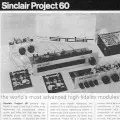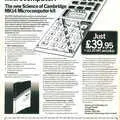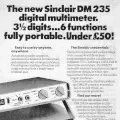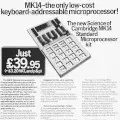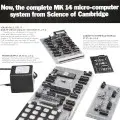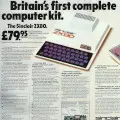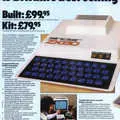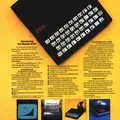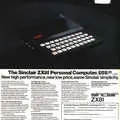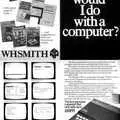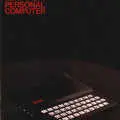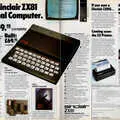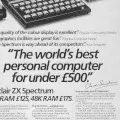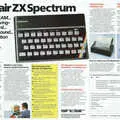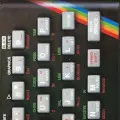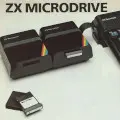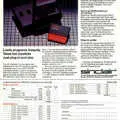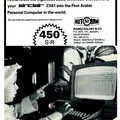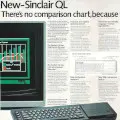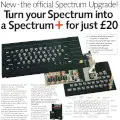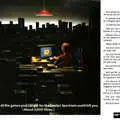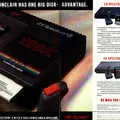
Sinclair Advert - December 1985
From Your Computer
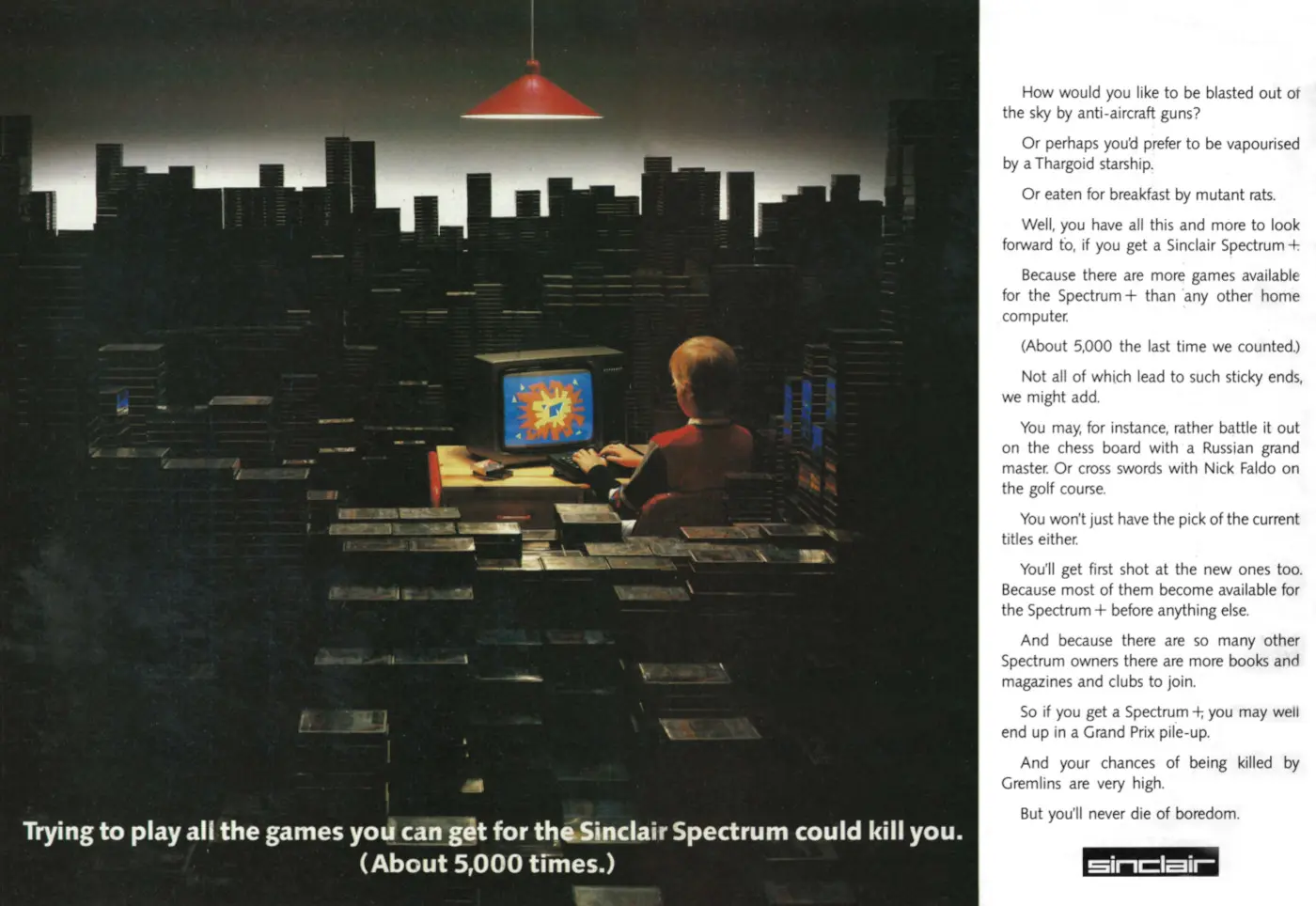
Trying to play all the games you can get for the Sinclair Spectrum could kill you (about 5,000 times)
Perhaps the first time that "software sold a machine" was when the release of Visicalc saved the Apple II in 1979, but certainly by the mid 1980s the availability of software had become a significant factor in the success of new or established machines.
Companies like Commodore would often advertise how many titles were available for their machines and others like Sord would even launch developer programs in order to prop up flagging sales of their machines due to a paucity of available software[1].
Even Sinclair's follow-up machine, the QL, was significantly held back not just by its infamous MicroDrives but by the lack of titles available for it.
This particular advert claims 5,000 titles for the Spectrum+ - a micro essentially the same as the 1982 original, but with real keys - which is certainly comparable to the 6,000 it was thought the Commodore 64 had available at about the same time[2].
The Speccy ended up beating this by a long way as it went on to have some 24,000 titles available for it by 2012[3] with the C64 trailing behind with a relatively modest 10,000 titles[4].
Nintendo's FamiCom
In Japan, back at the beginning of 1985, there had been a text-book example of how software sold machines.
Whilst other Japanese micros, in the shape of the dull Microsoft-sponsored MSX standard, had failed to make an impact, Nintendo had been quietly selling its little-known-outside-of-Japan "Family Computer" at the rate of 10,000 machines a day - more than the Jupiter Ace sold in its entire production run - and had sold no fewer than 2.3 million machines between when it launched at the end of 1983 and the spring of 1985.
The FamiCom cost only £48 (£190 now) and looked like a regular games machine in the style of the Atari 2600, although it was possible to buy a plug-in cartridge with Basic and a keyboard for it.
However, it used custom chips to give incredibly fast graphics which looked realistic and smooth and all in full colour, a combination which appeared to have hit a sweet spot even for seasoned arcade players.
At a time when the wider industry was in crisis since Atari (which was by now at the point of bankruptcy) had saturated the market and where cheap home computers had in large part replaced dedicated games consoles, the FamiCom, despite actually only having around 30 titles, totally bucked the trend by managing to sell 14 million cartridges at £15 (£60) each by February 1985.
Shinichiro Kakizawa of Personal Computer World said that "Users are certainly tired of low-quality video games but not of these high-quality products".
Nintendo was expecting to sell another 3 million FamiComs in Japan and was making plans for a US and possibly UK invasion[5].
Hope springs eternal
A few months before this advert, and shortly before it was canned, Sinclair had reduced the price of its troubled QL by a whopping 50%, from £400 down to £200, or £800 in 2025.
Sinclair put a brave face on the massive reduction, with UK sales and marketing manager Jane Boothroyd saying:
"We have reduced the price of the QL to consumers in line with reduced manufacturing costs. We will achieve major savings from our substantially increased manufacturing volume, based on sales commitments received to date and with more in the pipeline".
Of course it was entirely coincidental that the price cut was announced just two days after Amstrad formally launched its 6128 and highly-influentual PCW 8256 machines[6].
Sinclair also continued to make some efforts to prop up the lack of software for the QL, announcing the release of a text adventure game during October 1985.
The game was called "The Pawn" and utilised a complex language parser which, according to the appropriately-named Anita Sinclair of developer Magnetic Scrolls, meant that users could "use very complicated sentences and [the game] will understand almost anything".
Unfortunately for Sinclair, the game was also available, courtesy of Firebird, for fellow 68000 machines the Atari ST (where it also included graphical screens that the QL couldn't do), Commodore's Amiga and the Apple Macintosh, although the latter two were intended for the US market only[7].
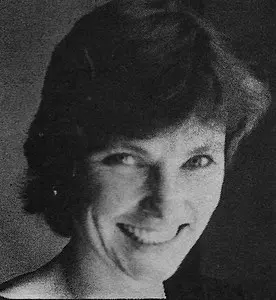
Alison Maguire of Sinclair, © Popular Computing Weekly 11th August 1983Sinclair seemed to be vindicated in its slashing of the QL price if figures released in October by Audits of Great Britain were anything to go by.
The results showed that Sinclair - despite all its financial problems - accounted for 56.8% of the UK market in the four weeks ending September 7th 1985, which was a 20% gain over the same period in the previous year.
The QL price cut seemed to have improved the machine's fortunes by 5.8%, but it was still the Spectrum - in the form of the Spectrum Plus - that was accounting for 50.5% of sales.
Alison Maguire of Sinclair said "Since the survey we have seen that the price drop on the QL has had a huge impact on sales".
It really did seem that Sinclair would be able to ride out its financial crisis and the collapse of the Maxwell deal on the back of its Spectrum and QL sales, without having to complicate its Dixons deal, in which it had agreed not to launch any new machines until 1986, by selling a version of the Spanish 128K Speccy.
Maguire was forthright on this: "We have no plans to launch the machine here" before continuing "It is however an option for next year"[8].
Unfortunately, the writing was on the wall for Sinclair, as a massive stock writedown of £22.5 million on its excess stocks of Spectrums and QLs led to it reporting an £18.3 million (£72 million in 2025) pre-tax loss at the end of 1985.
The loss was despite the continued growth in revenues, up to £102.8 million to the end of March 1985, and Sinclair's improving export market, which by now was making up 40% of the company's sales, but was exacerbated by a significant lack of business during the first quarter of 1985, when the company virtually ceased making deliveries to retailers[9].
By the end of the year, Sinclair's major creditors met for the second time to decide the company's future, opting to give it time to ride out the all-important Christmas sales period.
News that Rumbelows had decided to discontinue sales of Sinclair micros at the end of October 1985 wouldn't have helped, although the decision was as much to do with the fact that Dixons had bought up huge stockpiles of unsold Spectrum Pluses in the summer[10] and was flogging them off as a bundle at £140, or as Rumbelows' buyer Terry Greenwood put it "Dixons seems to have tied up that particularly area of the market".
Instead, the high street retailer was offering Commodore's 64, also in bundle form, as well as a Toshiba MSX machine and - tellingly - Amstrad's CPC 464 and 6128, which was also available at Boots, Laskys, John Menzies and WHSmith[11].
No-one saw that coming...
On the 7th of April 1986, the computer industry was shocked by the news that Amstrad - the brash new upstart founded by Brentwood "barrow boy" Alan Michael Sugar and which so far had been mostly famous for budget hifi - had bought Sinclair's computer business for £5 million in spare change (about £18 million in 2025), as well as buying the remaining stock for £7 million, effectively wiping out Sinclair's debt.
At a press conference Sugar, who had previously referred to Spectrums as "pregnant calculators", didn't seem to have thought his reasons for buying Sinclair through, saying somewhat off-handedly that Sinclair "has dominated the entertainments market in Europe [and] an on-going entertainments market is viable".
But maybe there it was: Sugar, having noted Nintendo's sales of nine million units of its games console during a recent visit to Japan, seemed to view the Spectrum as a way to buy the games market in the UK and Europe, in particular as its own CPC 464 - its own closest competitor - hadn't even been manufactured for some time.
Having bought the entire UK home computer industry for only £5 million - which to Amstrad was just back-of-the-sofa change - a refurbished Spectrum with a new keyboard and a joystick controller and sold as Amstrad's only pure games machine made sense, especially as Sinclair was also big in France, Germany and Spain.
With Sinclair's 29% of the European market, it was second only to Commodore, and Commodore hadn't spent any of its money on a purely-games machine since the failure of the C16[12].
Back at Sinclair HQ, it was also reported that staff were "angry" that Sir Clive had apparently rejected an alternative offer which would have meant the company would keep its Sinclair brand name - the offer being rejected as it would have mean Sir Clive ceding control of the company he had founded.
Sir Clive, meanwhile, claimed that he thought the other offer was "implausible", even though it had been supported by Sinclair's Chief Executive Bill Jeffrey.
The remains of the company were carved up such that Sinclair - the man - kept hold of his semi-secret telecommunications division, based in Winchester, as well as the elusive Pandora portable and his Metalab/Anamartic offshoot, where his wafer-scale research project was underway.
Breaking up is hard to do
The break-up was not without "collateral damage, as over 100 redundancies had already been made at Sinclair, and ten days after the deal it was still not certain how many people would be continuing to work for the new Sinclair Research[13].
There was further confusion when it was revealed that Timex Portugal - part of Sinclair's Dundee-based manufacturer and US distributor - had signed a deal to ship Timex's US Spectrum, the 2068, to schools in Poland, with a rumour in the press that Timex had even secured the rights to the whole of Eastern Europe just before the Amstrad take-over, contrary to Alan Sugar's assertion that Amstrad's purchase came with "worldwide rights"[14].
The timing of this announcement was particularly fortunate as only a few weeks later a fire at a Hungarian microchip plant wiped out the country's manufacturing capacity, leaving an opening for Western companies to expand into Eastern Europe.
Although the US had started easing its COCOM trade restrictions the previous year[15], it was was continuing to block the sales of more advanced machines like IBM's PC or Sinclair's own QL, however the Spectrum, being an old 8-bit design, was very much under the radar and could be sold into the potentially-huge and largely-untapped Eastern European markets.
Takis Patrikarakos, who had negotiated the 800,000-machine Polish deal, stated "I did not start the fire, but the arrival of the Spectrum in Poland could signal the adoption of the machine throughout the Eastern Bloc"[16].
Amstrad for its part was set to rapidly "de-stock" the QL, the machine which Sugar had already said had "not attracted the best publicity" and of which he "didn't see much future in", but was keeping the Spectrum, with plans already afoot to release a new version by the Christmas of 1986.
There were even rumours that Sinclair Research had been developing a games console in Cambridge, featuring more memory and possibly the credit-card software cartridges that Sinclair had been looking into for the Pandora.
Even if none of these made it in to the Spectrum, it was already considered a given that the new machine would be designed along the lines of Amstrad's "one box" philosophy[17].
As for the QL, a consortium of companies which had previously supported it had already expressed an interest in buying the rights to the thing, with the intention of upgrading it to 512K, a full 68000 processor and actually-standard 3½" floppy disks.
By the end of May, Amstrad had successfully dumped its stocks of older Sinclair machines to export house PST, which had paid a rumoured £2.6 million (£11 million in 2025) for the 20,000 QLs, 17,000 48K Spectrums and 14,000 16K Spectrums left after the purchase of Sinclair.
The overall deal seemed to annoy many dealers as most of the dumped stock and software was subject to "not in the UK" stipulations, with one anonymous dealer being quoted as saying:
"Alan Sugar has built up a lot of enmity for himself. I want to buy QL software, but I'm told the person he sold it to has been instructed to sell it out of the UK".
Amstrad was also insiting that owners take any faulty Sinclair machines back to the original dealers, and was then charging dealers for any repairs undertaken - a situation not expected to exactly help get faulty machines repaired, whilst software publishers stuck in Sinclair publishing deals were in the process of returning to solo distribution, although this was expected to take a month or more to sort out[18].
Elsewhere, dealer MCI, which had become the leading exporter of Sinclair products by the time Sinclair was bought by Amstrad, was rumoured to be considering importing the Micro Digital Spectrum-compatible micro from Brazil, whilst the exclusion of other dealers from the sold-off stocks prompted speculation that they might get together to produce a Spectrum-compatible micro in the style of the Brazillian machine.
The problem with such an approach was that, unlike the IBM PC, where the BIOS was small and easily reverse-engineered and the main OS was directly licenseable from Microsoft, the Spectrum required the entire Sinclair operating system to work, and this was now very much under Amstrad's copyright[19].
Also unlikely to ever see the light of day was Sinclair's Loki "Super Spectrum" machine, which had been intended as a souped-up 7MHz Z80-based games micro with 128K dual-ported RAM - which allowed a simple form of two-way multi-tasking - and more ports than you could shake a stick at and which was positioned as a £200 Amiga killer.
It turned out that the highly-complex project wasn't yet very advanced at Sinclair Research, and the sums required to release it would be significant even for a cash-rich company like Amstrad.
One Amstrad insider was quoted as saying that the company had "no intention of doing anything with the machine", whilst Spectrum expert Andy Pennell suggested that "It could work, but would have required Sinclair to put in a lot of investment"[20].
As for disks, after the fire-sale to Amstrad there appeared to be something of a crisis over the availability of Microdrives - the quirky, non-standard self-inflicted millstone that Sinclair had hung upon itself.
Panic over future supply and widespread shortages subsided somewhat by June when British Telecom offered up its stocks of 15,000 cartridges.
BT also used Microdrives in its QL-based Merlin (also known as the One per Desk, or even the Tonto) but had reduced its asking price for disks down to what one dealer called "a reasonable level".
Sinclair also offered up its own stash of 8,000 program cartridges, most of which it was thought would be reformatted to blanks for sales with a trade value of about £1 per cartridge.
Meanwhile the manufacturer of the actual cartridges - Ablex - was apparently in talks to buy back the rights to the cartridge, which would enable it to resume production[21].
A triumph of marketing
As Popular Computing Weekly pointed out in an editorial in the week following the news of the takeover, Sinclair - which it credited with inventing the home computer industry in the UK - had not really changed much in the years since it had been founded, whilst the industry around had changed enormously.
It had originally grown out of the hobbyist market, where buyers were used to working around quirks with a soldering iron, sticking memory packs onto their ZX81s with Blu-tac or making their own leads up to get things to work, and was still essentially the same research company.
Amstrad, on the other hand, was a marketing company which specialised in using tried-and-tested, or as Popular Computing Weekly suggested, even boring technology and packaging it up as a consumer item - a policy which had been spectacularly successful and which made Amstrad just about the only company in the industry making any profit - only Apple was in the same league and it needed a turnover of nearly £1.5 billion to make its £48 million profit for the year up to September 1985[22].
Even Uncle Clive admitted as much when he said of the deal that:
"In computers, we see ourselves as pioneers in technology. We have now handed the business over - rather later than we should have done - to a proven marketing company"[23].
Popular Computing Weekly concluded:
"Whatever happens now, an era has ended. Amstrad's share of the home computer market is now well over 50% and it will be a strong test of Commodore and Atari's stamina, creativity and marketing to keep up[24]".
Date created: 05 August 2014
Last updated: 12 March 2025
Hint: use left and right cursor keys to navigate between adverts.
Sources
Text and otherwise-uncredited photos © nosher.net 2025. Dollar/GBP conversions, where used, assume $1.50 to £1. "Now" prices are calculated dynamically using average RPI per year.
